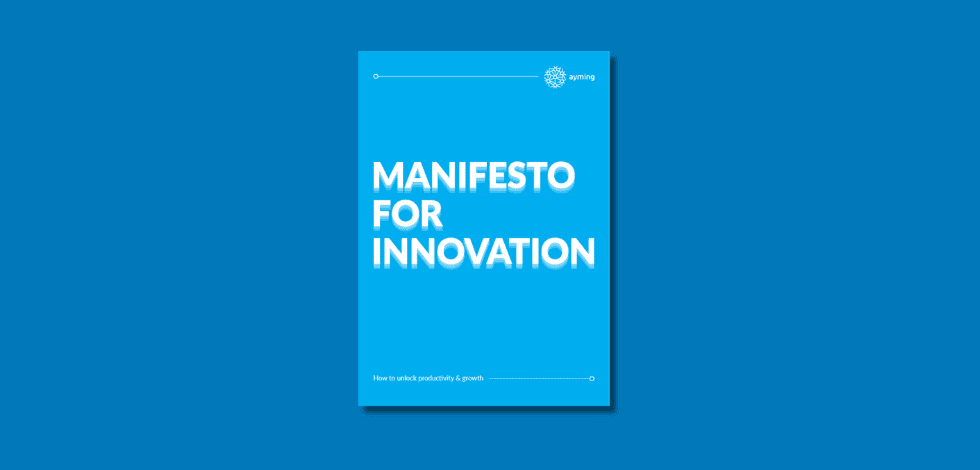Introduction
The following response is prepared on behalf of Ayming, Europe’s largest specialist innovation funding consultancy. We have experience of supporting businesses in claims for R&D reliefs, national and European grants, Patent Box, and other incentives across Europe and North America. Our response is based on the experience of preparing claims for thousands of clients, across a wide range of industry sectors and fields of science and technology, and in multiple jurisdictions around the world. In preparing this document we have sought to represent the views of clients of varying sizes and fields, and in particular those who do not have the time or resource to prepare a detailed individual response.
A brief note on terminology is required, given that there are several distinct reliefs with similar names under discussion in our letter. We refer to the schemes as:
- “RDEC” – Research and Development Expenditure Credit, as currently in place, defined by the Corporation Tax Act 2009 (“CTA09”) Part 3 Chapter 6A.
- “R&DTR” – Research and Development Tax Relief, as currently in place for SMEs, defined by CTA09 Part 13 Chapter 2 as currently in force.
- “Merged scheme” – the proposed new R&D expenditure credit, defined in the draft legislation under the proposed CTA09 Part 13 Chapter 1A.
- “Intensive scheme” – the proposed relief for R&D-intensive SMEs, defined in the draft legislation under the proposed amendments to CTA09 Part 13 Chapter 2.
This terminology is in line with that used by HMRC in briefing the R&D Communication Forum (“RDCF”) in July, although we appreciate that it is a temporary measure until the legislation is finalised. Nevertheless, given the clear difference between RDEC and the Merged scheme, we would recommend that a new term be found for the latter in legislation, to avoid any potential for confusion in administration of the schemes in future.
Download our full response letter here
Timing
We understand the Government’s intention to progress with the implementation of any changes, and in particular the creation of the Merged scheme and Intensive scheme having effect for expenditure incurred on or after 1 April 2024. (Draft Legislation, s16.) However, we are concerned that this is too accelerated a pace, given the significance and potential impact (discussed in later sections of our letter) of the proposals.
The proposed commencement date is barely eight months from the date of publication of the draft legislation, and little more than a year since the principle of creating a single scheme was first suggested. It seems unnecessarily hasty to push for implementation this rapidly, since it gives relatively little time to effectively scrutinise and revise the proposals to ensure their effectiveness. We note in particular that the window for this consultation is barely eight weeks, and that it is over August at a time when many key stakeholders may be on holiday. This could significantly impact upon the quality of the responses, as acknowledged in the Government’s Consultation Principles document. As a general observation, we believe that rushed legislation is rarely good or effective legislation, and take the view that it would be preferable to take the time to make decisions with due consideration to all relevant factors.
We also observe that the nature of R&D is that projects are often long-term undertakings. This means that decisions are taken about whether to progress with an R&D project well in advance (sometimes, several years in advance) of the expenditure being incurred. Many businesses have already committed to incurring expenditure after 1 April 2024, as part of decisions made about R&D projects already under way, or as part of budgetary planning for next year. Those decisions have been made in the knowledge and understanding of the RDEC and R&DTR schemes in place at the time, in line with the fact that these schemes function as an incentive to carry out such investment. For businesses to have committed to incurring that expenditure, only to have their claims significantly changed (and, in some cases, potentially removed entirely) does not seem fair. There is therefore a risk that businesses will start to ignore the existence of R&D reliefs in their decision-making processes, if they cannot rely on the stability of the schemes to provide a predictable level of relief. This aligns with Ayming’s experience around the world, where we have observed that the most consistent feature of effective R&D schemes (in countries such as France and Canada) is that they provide a stable and predictable level of relief; contrast this with the schemes (such as Italy and the USA) where there are regular amendments or a need for annual renewal, which are not factored into decision making due to the lack of stability.
Furthermore, there have been several significant changes to the existing R&D reliefs in recent years: the ‘rebalancing’ of the rates of relief in Finance Act 2023, the introduction of administrative measures (such as the Additional Information Form) in Finance (No. 2) Act 2023, and the increase in compliance activity from HMRC over recent years leading to increased scrutiny of the accuracy of claims. Given that much of the motivation for these changes was to reduce the widely acknowledged problem of error and fraud in the schemes (in particular, in SME R&DTR), it seems important to allow adequate time for these measures to take effect, so that their effectiveness can be properly ascertained. For there to be a further significant revision in such a short timescale means that it will be difficult to draw meaningful conclusions about whether any change in behaviour has occurred, or to which measure any change could be attributed. As such, the effectiveness of the measures to combat error and fraud cannot be properly ascertained.
In particular, we feel that the introduction of the Additional Information Form (“AIF”) in August 2023 was rushed, to the point of needing to be delayed by a week at very short notice. Primary legislation introducing the power to require the AIF was introduced in Finance (No. 2) Act 2023, and the AIF itself was consulted on in early 2023 in parallel with this. Despite that, the Statutory Instrument enacting the AIF was not published until barely two weeks before it took effect, leaving many companies preparing claims without a clear understanding of what the requirements might be. We also note that that legislation was effectively retroactive, since the requirements it brought in applied to claims made in respect of expenditure incurred before it was even introduced. Finally, HMRC’s analysis (at time of writing) indicates that barely half of claims submitted since the introduction of the AIF have complied with the requirements. (HMRC email to RDCF, August 2023) While any significant change is likely to have ‘teething problems’, non-compliance of this magnitude indicates a more fundamental problem, which we believe to be attributable to the rushed and confused nature of the introduction.
We would therefore propose that any change be deferred to take effect from 1 April 2025 at the earliest, in order that Government can take appropriate time to consider the effect of the proposed measures, and so that companies may take appropriate notice of the revisions in their decision-making processes.
Treatment of subcontracting
The draft legislation proposes that the following condition will apply to any company claiming under the Merged scheme:
Condition A is that the activities in the course of which the expenditure is incurred are not contracted out to the company by another person in the course of a chargeable trade carried on by that person.
This clause closely parallels a similar requirement currently applicable to claimants for R&DTR, found at CTA09 s1052(4), which has been problematic in recent years due to differences in interpretation. We note that there is no similar condition in the RDEC scheme.
It is clear that the clause is intended to prevent the possibility of ‘double claiming’, that is, two companies claiming in respect of the same activity and expenditure. This is a sensible principle, and one with which we agree. Correspondingly, we also believe that, where R&D is being undertaken, someone should be able to claim, and that (in line with the overall principle of simplification of tax legislation) it should be clear which party to a contract should be entitled to claim. However, neither of these objectives is met by the current proposal.
The problem originates from HMRC’s interpretation of the current SME clause, which we suspect would be transferred to the new clause given the similarity in wording. This interpretation is explained in the CIRD Manual:
Any activities carried out in order to fulfil the terms of a contract are considered to have been contracted to the company.
We note that, confusingly, this section of the CIRD Manual addresses the meaning of subcontracting as applicable to eligible costs, rather than to the eligibility of a company to claim; however, it is referred to in a separate section which does address the latter point. Of critical importance, this interpretation is one which has changed in recent years; prior to November 2021 the CIRD Manual instead stated:
Where there is a contract between persons for R&D activities to be carried out by one for the other, then the R&D activities have been subcontracted. A contract to provide services rather than to undertake a specific part of the activities is not subcontracted R&D.
and
Where one company engages another company to carry out R&D activity on the first company’s behalf in exchange for payment, with the first company having rights to the intellectual property resulting from the R&D then that is subcontracting of the R&D to the second company.
This is a more sensible interpretation, which is agreed with by the majority of advisers and companies claiming R&DTR, and also appears more in line with the intention of Parliament in enacting the legislation.
As a result of the differences in interpretation of the clause, a significant number of claims are under enquiry where HMRC is seeking to disallow R&DTR claims made by SMEs, in some cases in direct contradiction to the conclusion of enquiries into previous claims where the facts are virtually identical. Ayming is aware that at least 13 cases are currently awaiting hearing at the First Tier Tribunal where this question is the primary point of disagreement between HMRC and taxpayer. To that end, it would seem imprudent for Parliament to introduce a virtually identical clause that would affect all claimants, rather than just SMEs, when the opportunity exists to revise the legislation to further clarify the intent. It seems likely that, if enacted as proposed, HMRC would seek to disallow claims made by large companies on the same basis. If that were done, however, we believe many such companies (with significantly greater sums at stake) would also seek to litigate on the point. Given HMRC’s limited resources, this does not seem a sensible use of time or money; nor is it in line with the overall concept of the R&D reliefs as an incentive.
We draw attention to several situations, specifically within the construction sector, where HMRC current interpretation of this clause leads to situations which do not appear in line with the intent of the legislation. We represent construction businesses which have been engaged to construct buildings to the requirements of their customers, the owners and ultimate users of those buildings; for example, a major London hotel and a Premiership football club. Due to the nature of the buildings required, R&D has been required to construct them to the requirements of those businesses. Under HMRC’s interpretation, this R&D has been subcontracted to the primary contractor, which is then ineligible to claim R&DTR (and would be ineligible under the Merged scheme as proposed). Instead, it would be the customer in this instance who is eligible to claim, but this appears to create the ludicrous situation that a hotel and a football club are entitled to claim for R&D conducted in civil engineering; even if they are aware that R&D is being undertaken, it unlikely that they have the competence to properly evaluate the extent to which the work is eligible, nor is the potential to claim likely to influence their decisions as to whether to proceed.
The question then arises: which party to a contract should be entitled to claim? HM Treasury’s report on the consultation on a single scheme indicates that ‘most’ respondents indicated a preference for the customer, on the basis that the company carrying the financial risk should benefit. However, we believe there is a flaw in the logic here – where it is understood by both parties that R&D is necessary for the fulfilment of the contract, and forms a part of the activities contracted out, it is reasonable to conclude that the customer is incurring financial risk. However, this is not the case in many of the situations outlined above; instead, it is the subcontractor that is incurring financial risk, since it has agreed to produce an end result without complete knowledge of what will be required to deliver that, or what expenditure must be incurred to achieve its goal. This is the case in the situations described above; the primary contractor is committed to delivering a building to a specification and for an agreed price, but the financial risk as to how to deliver that (or indeed, whether it is possible at all) lies with that business and not the customer. Therefore, if the company taking on the financial risk is the intended target of the relief, the proposed legislation fails to achieve that.
There is also a concern that, under the terms of the proposed legislation, the companies that are entitled to claim would have little or no knowledge of R&D being undertaken. This presents two potential problems. Firstly, the company entitled to claim would fail to do so due to lack of awareness that it is eligible. This does not align with the principle outlined above that, where R&D is taking place, someone should be able to benefit from a claim. Furthermore, if the company that is able to claim is unaware of its eligibility, it cannot factor the claim into its decision-making process; as a result, the R&D relief fails in its objective of incentivising R&D.
The second problem is that the claiming company would lack the technical competency to properly evaluate the R&D, and prepare an accurate claim. Consider the examples we describe above: neither a hotel nor a football club employs civil engineers able to determine whether R&D is being undertaken. As a result, there is a risk that such companies could prepare inaccurate or poorly documented claims; this would increase the risk of erroneous claims (contrary to the objectives of other recent amendments to the schemes) and increase the burden on HMRC in needing to engage in compliance activity.
Also worthy of discussion is the new wording in the draft legislation, requiring the customer to a subcontract to be carrying on a chargeable trade. This is not part of the equivalent clause in the R&DTR scheme. It appears to have been introduced to allow a UK company to claim when the customer is overseas, and hence not subject to UK tax and eligible for UK reliefs. In principle, this is a laudable objective – it is entirely in keeping with the intention of the schemes that UK companies that attract foreign investment in R&D should be incentivised. However, the implementation is burdensome; there are few other scenarios where a company is required to consider whether its customers are carrying on a chargeable trade, and certainly there are situations that might arise where the status of the customer is not clear to the subcontractor (for example, a foreign company with a UK permanent establishment is taxable; a Government-owned entity may or may not be carrying on a chargeable trade; or a company may be in a pre-trading state for part of the period of the contract). This could leave some companies unclear as to whether or not they are affected by this condition, with the obvious resultant potential for incorrect claims.
We recommend that there be two changes to the draft legislation:
- The opportunity should be taken for Parliament to clarify what it intends by ‘subcontracting’, and hence, under what circumstances such a clause should apply. This could be as simple as refining the definition to say ‘subcontracting R&D’, albeit that may be overly simplistic. A parallel can be drawn with the definitions cost categories of qualifying expenditure within the schemes: staffing costs, externally provided workers (“EPWs”), and consumable costs are all defined in detail within the primary legislation, making it clear what costs can be included. Government should engage with businesses to understand the contractual nature of subcontracting (both generally, and of R&D-specific activities) and develop a better definition. We note this was suggested in many responses to the earlier consultation, and it is disappointing that the draft legislation has not acted upon that recommendation.
- The legislation should be revised to parallel the current RDEC scheme, rather than R&DTR. This would bring the benefit of providing relief to the company actually undertaking the R&D (and hence incentivising businesses to do so), as well as ensuring the company claiming has the competence to prepare the claim accurately. This would also have the advantage of being the simplest option, allowing no ambiguity over which company is able to claim, and hence removing the potential for double claiming.
In the event that the latter option is not palatable, we believe further options for the treatment of subcontracting should be reconsidered; other options warranting more detailed scrutiny include the ‘joint election’ option; a route similar to that undertaken in the Irish scheme (where subcontracting costs can be included subject to a notification being made, but a subcontractor is entitled to claim in the absence of such a notification); or a process similar to the French scheme where the customer is entitled to claim only in respect of costs paid to an approved list of subcontractors. For clarity, we do not recommend any of these options as being good (the administrative burdens are large in all cases, and they can lead to disagreements between customer and subcontractor), rather, we use them as illustrations of options that might be considered.
Crucially, we note that in all options under consideration, clarity of the definition of subcontracting, and the understanding of both parties to the contract that these rules apply, is fundamental to their effectiveness.
Download our full response letter here
Qualifying EPW costs
Contained within the draft legislation is a clause that further refines the definition of qualifying costs in respect of EPWs, specifically the proposed CTA09 s1132A. This proposes to restrict the qualifying costs for UK EPWs to only those costs in respect of which the staff controller is required to account for PAYE and NICs. This does not apply in respect of overseas EPWs, the costs of which are already restricted to a limited set of circumstances by other clauses. This clause, although ostensibly harmless, introduces a restriction on EPW costs in some circumstances, and a significant (in some cases insurmountable) burden on all claimants.
There are many circumstances in which a company may procure workers (for the purposes of its R&D activity) in respect of which PAYE and NICs are not operated by any entity. This might arise where a worker is engaged under “outside IR35” arrangements, or under the Construction Industry Scheme (“CIS”). Both of these schemes have been introduced with the specific objective of addressing evolving working practices and ensuring that appropriate tax is due and paid, and both schemes are entirely legitimate ways of engaging and procuring workers to carry out R&D. Under current legislation, payments made in respect of such workers are rightly eligible. However, under the proposed new requirement, this would cease to be the case, and the costs would no longer be eligible purely as a consequence of the commercial terms of the contract under which the workers were engaged. This is unfair; such commercial decisions should not affect the eligibility of those costs.
Furthermore, even where workers are engaged under terms where PAYE and NIC is operated by the staff controller, that is not information that will necessarily be available to the claiming company. The structure of the supply chain of EPWs (where a claiming company engages with a ‘staff provider’, but the workers themselves are under contract to a ‘staff controller’ potentially several stages removed from those entities) means that the claiming company may have no working relationship with the staff controller. Under these circumstances, the claiming company will be unable to ask whether PAYE and NIC is being operated; even if it has a mechanism to ask that question, the possibility exists that the staff controller may simply refuse to answer. The result, therefore, would be that the claiming company is unable to claim simply because it has no means to demonstrate it meets this requirement. Furthermore, the administrative burden (even in the situations where it can be met) would be significant.
It is unclear what the purpose of this clause is, or what problem it intends to solve. If the intention is to ensure that tax is paid in respect of workers engaged in R&D, there are already mechanisms in place (including the aforementioned IR35 and CIS) to do that. Introducing a complicated and burdensome clause to the R&D reliefs is not an appropriate place to ensure such compliance, nor is it aligned with the principle of tax simplification which is now the responsibility of HM Treasury and HMRC. If the intention is to prevent double claiming, again, the mechanisms exist to do this; neither the staff provider nor the staff controller are entitled to claim in respect of workers provided to another company, since only the latter is undertaking an R&D project. What then does this clause achieve?
We recommend that this clause be removed entirely.
Treatment of subsidies
The draft legislation includes a clause that would prevent any claim being made in respect of expenditure which is subsidised (that term being defined by existing legislation). A similar restriction exists in the current R&DTR scheme, but not in RDEC. This clause is, however, still under consideration, according to the accompanying Explanatory Notes.
It is not clear what the purpose of such a restriction would be. RDEC has no equivalent provision; the source of a company’s funding for its R&D projects being irrelevant to the eligibility of the claim. The motivation for the different provision in the R&DTR scheme is that R&DTR is a Notified State Aid, and (at time of introduction) EU legislation limited State Aids such that a company could only benefit from one of these; as such a restriction was required to prevent R&DTR claims in respect of expenditure that had received other aids. This was extended to cover other similar forms of aid that were not notified. However, expenditure that is not eligible for R&DTR as a result of this clause is instead eligible for RDEC. It does not seem sensible to change the underlying nature of the scheme to prevent any claim being made in respect of such expenditure.
We also draw attention to a further area of complication here, as regards the interpretation of the subsidy restriction in the current R&DTR scheme. HMRC has attempted to use this clause to reject a number of claims, although the precise explanation has varied from case to case based on the officer conducting the enquiry. It appears then that even HMRC is unclear exactly what its interpretation of the ‘subsidy’ clause should be. Further, one such rejection was overturned at the First Tier Tribunal in the case of Quinn (London) Ltd v HMRC, with commentary from Judge Harriet Morgan that HMRC’s argument was “out of kilter with the overall R&D scheme”. This decision was further referenced in HMRC v Perenco UK Ltd, similarly examining the definition of subsidy albeit in relation to Petroleum Revenue Tax.
Given the potential confusion over the circumstances in which this clause might apply, and the open question over the purpose of restricting relief in this way, we recommend the clause be removed.
Structure of the Intensive scheme
The Intensive scheme has been structured as an extension to the current R&DTR. Although this appears logical, given that it applies to SMEs in the same way that R&DTR currently does, we believe this is a flawed approach.
Firstly, the objective of creating the Merged scheme was to simplify the R&D legislation, and create a single scheme with a common set of rules applicable to all companies. This is a laudable objective and one with which we agree. However, to have a completely separate scheme, applicable to a small subset of companies, but requiring a substantial separate Chapter of legislation, is not aligned with that principle. Indeed, it retains much of the current complexity that the Merged scheme is intended to remove.
The Merged scheme is designed to parallel RDEC, as an ‘above the line’ credit, a positive decision with which we agree. The justification for this is extensive, and explained in responses to the Consultation on a single scheme held earlier this year. Indeed, the concept of the Merged scheme being similar to RDEC was noted as “broadly accepted among respondents” to that consultation. Many of these reasons are also those that justified the introduction of RDEC in 2013. All of those reasons will equally apply to companies eligible for the Intensive scheme. It does not seem logical to retain the structure of R&DTR for the Intensive scheme.
In particular, we are concerned that the Intensive scheme retains a critical flaw of R&DTR: that an SME can benefit (and the mechanism by which it does so) is dependent on the wider tax position of the company, and not merely on the level of R&D it undertakes. Furthermore, under some circumstances a company can realise its benefit on paper only, which can be extremely problematic for SMEs that are constrained by limited cashflow.
We recommend therefore that the Intensive scheme be amended to function in the same way as the Merged scheme (and replicating RDEC). This would bring the advantage that common legislation would apply to both schemes, removing complexity, as well as allowing the Intensive scheme to also offer the benefits of an ‘above the line’ treatment brings. The additional benefit for Intensive SMEs could be retained by offering an increased credit amount: we recommend a rate of 36% (in place of the Merged scheme’s 20%), which would offer a net benefit similar to the proposed Intensive scheme.
Definition of “R&D-intensive SME”
Fundamental to the operation of the Intensive scheme is the definition of “R&D-intensive SME”, which determines whether companies are eligible to claim under this scheme. We appreciate that this is a complex question, but the proposed definition requires some revision.
The definition (under the proposed CTA09 s1045ZA) is broadly that the qualifying R&D expenditure be at least 40% of its ‘total relevant expenditure’, defined as expenditure brought into account in computing the profits of the company’s trade. This is problematic because of that definition of ‘total relevant expenditure’, which can only be calculated as part of a company’s tax computations, some time after completion of the accounting period in which the expenditure is incurred. Therefore, a company will only be able to determine whether it is eligible for the Intensive scheme significantly after the expenditure has been incurred, and certainly well after decisions are made as to whether to incur that expenditure. Given that this will mean that the company will be uncertain of the level of relief it will be able to obtain, it seems unlikely that a company will factor the increased level of relief available under the Intensive scheme into investment decisions, and will instead have to assume that it will only be able to claim the lower relief available under the Merged scheme.
Furthermore, the definition is phrased so as to consider the R&D expenditure and ‘total relevant expenditure of all connected companies in aggregation. This is a sensible measure, since it would prevent the potentially abusive behaviour of a relatively low-intensity company setting up a subsidiary to carry out only R&D, and thus become intensive by artificial means. However, the definition only accounts for UK expenditure (both R&D and total), and as a result a multinational group that is not overall intensive, but which has a UK subsidiary that is intensive, would qualify. This does not appear to be aligned with the overall objective; two equivalent groups would be treated differently depending on whether they are entirely UK-based or partly overseas. In particular, it is counterintuitive to incentivise businesses to keep non-R&D activities offshore, in order to maintain R&D-intensive status.
We therefore recommend that this definition be revisited, and a better mechanism be developed for determining which companies are eligible for the enhanced level of relief aimed at R&D-intensive SMEs. Some options that could be considered include:
- Use of expenditure deductible in statutory accounts. This would bring the advantage of being calculated much earlier in a claimant’s accounting cycle, and would typically be a part of a company’s financial budgeting. However it is more open to the potential for manipulation and abuse.
- Use of the previous year’s deductible expenditure. This would give certainty over the criterion at a much earlier stage; but it seems counterintuitive given that R&D intensity may fluctuate year-on-year.
- Use of a metric based on the staffing costs (or headcount) of the claiming company. This would be much more predictable means of assessing eligibility and could easily be determined by a claimant on a rolling basis throughout the year. Care should be taken, however, to ensure that companies with relatively large proportions of their R&D expenditure being non-staff costs (particularly true of startups) are not penalised.
Note that we have not evaluated these options in detail, nor do we recommend any particular one; rather, they are listed here to demonstrate the range of options available.
In addition, some companies that are routinely close to the threshold could drop in and out of the Intensive scheme, despite relatively small fluctuations in R&D expenditure or in ‘total relevant expenditure’. For example, a company that typically meets the criterion by achieving an R&D intensity around 42%, but which incurs an unusually high amount of non-R&D expenditure in one year could find its intensity dropping to 39%, and thus becoming ineligible for the Intensive scheme for that year only; before returning to its previous level (and requalifying) the following year.
This reiterates the previous point – that the company faces uncertainty over which scheme, and hence what level of relief, it is eligible to claim. However it might also encourage abusive behaviour, with a company potentially seeking to inflate its claim to push itself over the 40% threshold purely to claim the higher level of relief.
We therefore recommend that a transition period similar to the ‘year of grace’ in the definition of an SME be adapted. That is, that the loss of R&D-intensive status would only occur if a company fails to meet the criterion for two successive accounting periods; but will retain that status for the first period in which it fails to qualify.
Step 2 – notional tax deduction
The Merged scheme is proposed to function in a manner very similar to RDEC, in that it provides an ‘above the line’ credit (treated as revenue to the claiming company) which is taxable. It also closely parallels RDEC in the manner in which that credit is realised by the company: a ‘seven step’ process which (in summary) uses the credit to pay outstanding tax liabilities, before the balance is paid to the company as a cash credit. We agree with this approach, with one caveat.
There is a technical problem with one provision of this process (which deviates from the current RDEC equivalent), specifically the ‘notional tax deduction’ at Step 2, defined in the proposed CTA09 s1042J. This deducts an amount, equal to the Corporation Tax due at main rate on the entire credit. This is problematic in the scenario that a company has used some, but not all, of its credit at the preceding Step 1 – at this point it has already paid Corporation Tax on the credit; therefore a ‘notional tax deduction’ should not also apply at Step 2, since this effectively means the company is taxed twice on its credit.
Under the current RDEC scheme, a similar deduction is made, only here the amount deducted at Step 2 is that amount that would reduce the balance remaining after Step 2 to the credit amount net of tax.
We recommend that Step 2 of the Merged scheme be changed to replicate Step 2 of the RDEC scheme, by copying the provisions of CTA09 s104N (2) and (3).
Removal of Contributions to Independent Research
We are surprised by the omission from both the Merged scheme and the Intensive scheme of one category of qualifying expenditure, Contributions to Independent Research (“CIRs”). Such expenditure is claimable under RDEC (but not R&DTR), under the circumstances prescribed in CTA09 s104L.
Expenditure in this category is uncommon, and rarely forms a significant part of the value of claims. However, where present, it usually represents the most ‘pure research’ aspects of companies claims, since it takes the form of payments to specialist research organisations and academic institutions to carry out R&D on the company’s behalf. This means it is the R&D that has the highest technological risk and is furthest from a commercial application, therefore potentially the R&D most in need of Government support.
There has been no policy announcement or consultation on this topic, so it is not clear why CIRs are being removed. There certainly seems little justification for that removal, and it is possible that it is merely an omission in error.
We recommend that CIRs be eligible for the Merged scheme. Failing that, the Government should make a policy announcement explaining the reason for their omission.
Items not addressed in the Draft legislation
There are several areas that are not mentioned anywhere in the Draft legislation, some of which were examined in the consultation in early 2023. It is not clear whether these areas have been considered and discarded following the consultation, or whether it remains the intention to revisit them at a later time. Two areas in particular warrant discussion:
- Qualifying Indirect Activities (“QIAs”). The consultation this spring examined whether the inclusion of QIAs in the R&D schemes influences decision-making processes, and attracted a mixed set of responses. However, there is no reference to QIAs in the draft legislation, nor have they been mentioned in any subsequent policy paper (beyond explicitly excluding QIA costs on cloud computing and data from their introduction in Finance Act (No. 2) 2023). It therefore remains unclear what the Government’s intention is in this area: will QIAs remain eligible or not? If not, will they be replaced by any of the alternatives suggested in the consultation?
- A minimum threshold. The consultation examined whether a minimum threshold should be introduced, and if so, at what level. Again, this elicited a variety of responses, both as to the principle of introducing a threshold and the level. There has likewise been no reference to this in the draft legislation or any policy announcements since, and again it remains unclear what the Government’s intention is.
The uncertainty over the Government’s intention in these areas is unhelpful, since it leaves open the question of whether and how much a company will be able to claim. This makes it difficult for claimants to effectively plan their R&D expenditure. We repeat our earlier observations, that the R&D schemes must be stable and predictable to be effective.
We recommend that the Government make its policy clear in these areas, through a clear set of proposals, or at least a statement that there is no intention to change the status quo. In the event that a change is intended, draft legislation should be published and consulted on as soon as practical.
Impacts of the proposed changes to R&D schemes
HMRC’s Policy Paper discussing the proposed Merged scheme and Intensive scheme includes (as it must) a summary of the proposed impacts of these changes.
Rather startlingly, the proposals are expected to have no effect on Exchequer revenue in any of the financial years from 2023-24 to 2028-29. Given the scale of the changes to the R&D reliefs, which could significantly affect the amounts claimed, the benefits received, and (in particular) which companies can claim, this seems highly implausible. We note that all previous modifications to the schemes, particularly the introduction of RDEC in 2023, have resulted in significant changes to the amounts, and hence the levels of relief, claimed. Unfortunately, no information is publicly available regarding the derivation of HMRC’s conclusions, and therefore we cannot further comment on their accuracy beyond the highly implausible nature of the result.
The Policy paper also estimates that there will be “no significant macroeconomic impact”], and states that “The impact on businesses… will be estimated following the final scope and design of the policy.” Given that the R&D schemes are, by their very design, incentives to influence business decisions and behaviours, with the objective of improving the overall economy, surely these impacts should be considered in more detail before any policy decision is made? At the very least it seems reckless to make significant changes to the schemes without understanding their impacts more thoroughly.
Note also that (in 2022) the Office for National Statistics revised its approach for quantifying the levels of R&D undertaken, particularly by small businesses. This acknowledged that the previous methodology undertaken had underestimated the level of R&D undertaken by small businesses, and revised that methodology on an interim basis to provide a more accurate result. The primary motivator for this revision was to address the widening gap between the ONS report on the levels of R&D and the amounts claimed in the R&DTR scheme. There remains some uncertainty over the accuracy of the resulting methodology, however, meaning that it is difficult to say with confidence how much R&D is undertaken by SMEs. Therefore, it must inherently be difficult to determine the level of impact that the proposed changes to the R&D schemes will have on that level, and on the amounts claimed.
We repeat our earlier recommendation that any decisions be delayed, until their economic impacts have been properly determined and assessed.
Summary of recommendations
We conclude by summarising the recommendations Ayming has made throughout this document:
- A new name be determined for the Merged scheme, to avoid confusion with the existing RDEC scheme.
- Any change be deferred to 1 April 2025 at the earliest, to allow Government time to properly consult on and consider the impact of the proposed measures, and to allow businesses time to adapt.
- The definition of ‘subcontracting’ should be clarified in primary legislation, to avoid the current confusion, disagreement, and litigation over this point.
- The draft legislation should be revised, so the treatment of subcontracting parallels the current RDEC scheme not R&DTR.
- The new requirement that EPW costs be subject to PAYE/NICs should be removed.
- The requirement that expenditure eligible for the Merged scheme not be subsidised should be removed.
- The Intensive scheme be structured in the same way as RDEC and the Merged scheme (i.e., as an ‘above the line’ credit not a super-deduction), at a proposed rate of 36%.
- The definition of an ‘R&D-intensive SME’ should be revisited, and changed to a more practical and predictable one.
- A transition period of two years paralleling the ‘year of grace’ should be adopted for companies moving out of the ‘R&D-intensive SME’ definition.
- Step 2 of the Merged scheme should be modified to replicate Step 2 of RDEC.
- CIRs should be eligible for the Merged scheme, or the Government should make a policy announcement explaining the reasons for their omission.
- The Government should clarify its intentions with regards to QIAs and a minimum threshold for R&D.















No Comments